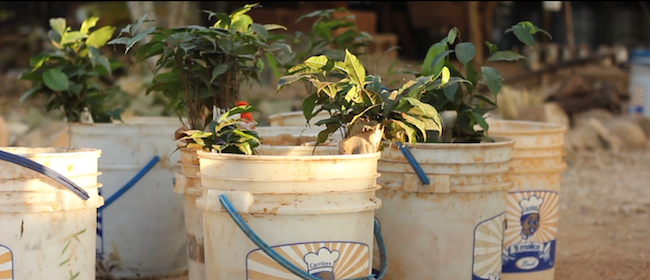Food Forests
The idea of forest gardens (food forests) was first articulated by Robert Hart in his book ‘Forest Gardening’ and subsequently became one of the keystone concepts in Permaculture. A Permaculture forest garden mimics the architecture and beneficial relationships of a natural forest. Food forests are not ‘natural’, but are designed and managed ecosystems that are very rich in biodiversity and productivity. It is based on a philosophy of co-operation with nature and each other; of taking responsibility for our impact on population and our consumption of things which have high environmental costs.
A food forest typically is comprised of seven layers: the uppermost layer is the canopy layer that is comprised of tall trees, mostly large fruit and nut trees. Between the tall canopy layer trees there is a layer of low growing fruit trees, and nestled between all these small trees are the shrubs which are well represented by currants and berries. Filling the remaining space is the herbaceous layer: these are the culinary and medicinal herbs, companion plants, bee-forage plants, and poultry forage plants. Any remaining space is occupied by ground cover plants, which form a living mulch that protects the soil, reduces water loss to evaporation, and prevents weeds from growing. While that might seem like a lot of plants in one space, we still have one more to fill: the upright vertical space. This is filled by climbers and vines, which can be run up fences, trees, or any other vertical support. This category includes grapes, climbing beans, many berries, passion fruit, kiwi fruit, climbing peas, and many other species that love to climb.
The benefits to be realized from food forests are as follows: high productivity; natural mulch, compost, & fertilizer; natural pest control by using natural predators, and a resilience that can only come through biodiversity.
A food forest is built to emulate a real forest — only we fill it with the food plants and trees that we want. Real forests do not need any work, they self-maintain — no pesticides, herbicides, weeding, crop rotation, mowing or digging. Food forests do not need any of this either!
1 http://www.permaculture.org/nm/index.php/site/Permaculture-Food-Forest/#sthash.MLmXTMlD.dpuf
2 http://foodforest.com.au/about-us/permaculture/
3 http://permaculture.org.au/2011/10/21/why-food-forests/
4 http://permaculture.org.au/2011/10/21/why-food-forests/
5 http://permaculture.org.au/2011/10/21/why-food-forests/
Maya Nut tree
Known as Yaxox in Mayan, the Maya nut tree can stretch to a height of 45 m (148 ft). The base of its trunk features external roots, which provide support for the tall tree. Its bark is thin, smooth and whitish-grey in color with a sticky, milky sap inside. The tree is adaptable to climate because it can grow in a large variation of temperatures, and thrives on dry rocky soil. The Maya nut used to be abundant throughout the forests of Central America. Its seeds were once a staple food of the Mayan people, as well as sustaining dense populations of deer, another Mayan staple. Its leaves, pulp and seeds continue to be central to the diet of many forest birds and animals. However, as areas of forest have been felled for timber and for maize, Maya nut numbers have declined and the tree has become extinct in some areas.
Humans commonly eat the orange fruit it produces, as well as the small, bright green seed (called, alternatively, ramón nut or bread nut) contained within it. The seed is an edible ‘nut’ that can be boiled or dried and ground into a meal for porridge or flatbread. The Maya nut is nutritious and has value as a food source. It is extremely high in fiber, calcium, potassium, folic acid, iron, zinc, protein, and B vitamins. Per acre Maya nuts provide 100 times more nutrition than corn. It has a low glycemic index (<50) and is very high in antioxidants. The fresh seeds can be cooked and eaten or can be set out to dry in the sun to roast and eaten later. Stewed, the nut tastes like mashed potato, roasted it tastes like chocolate or coffee and can be prepared in numerous other dishes.
This nutritious nut, which can be stored for up to five years, is an excellent drought and climate change-resistant food for rural communities. Entire villages have survived by eating Maya nut; the flour was used as a valued emergency food in Guatemala after Hurricane Stan (October 2005) and after Hurricane Felix in Nicaragua (September 2007).
Charcoal
Colonialism, globalization, and a growing urban population have put immense pressure on Haiti’s charcoal industry. This charcoal industry has, in turn, led to many other hardships for the country.
Deforestation has increased soil erosion in Haiti, thereby polluting the country’s rivers and increasing its susceptibility to flooding; this pollution and flooding have then damaged Haiti’s most important sector: agriculture. Apart from these environmental concerns, cooking with charcoal is said to have led to serious indoor pollution, causing respiratory illnesses in a nation that is already plagued with many other health concerns.
While Haiti’s charcoal industry is unsustainable and detrimental to the general health of its population and environment, there is no denying that it provides the country with important economic services. The charcoal industry employs an estimated 200,000 people, making it possibly the largest employer in Haiti. The charcoal industry also generates hundreds of millions of dollars for the economy, which is important considering that the country’s GDP is only $7.9 billion, and that 77% of its people live on less than $2 USD a day. The livelihoods of hundreds of thousands of Haitians depend on the charcoal industry, and displacing this industry could potentially lead to socio-economic challenges. Therefore, when evaluating potential cooking fuel substitutes, it is important to consider not only their technological feasibility, but also the impact each substitute may have on local populations.
One of the main reasons for deforestation in the Anse-à-Pitres (Haiti) area is the production of charcoal. Charcoal is the main resource for domestic energy needs such as cooking and is always in high demand.
Upon our arrival in Haiti we understood that this would be one of our biggest challenges and we devised a way to address this issue. Our goal in Haiti was not to plant in open areas where the trees would not be protected from the charcoal business and from livestock grazing. We understood that before planting a forest we would need to address the reasons for the initial deforestation and find proper alternatives and solutions for the population that depend on deforestation for their livelihood. We decided that the trees that would be distributed would initially be trees that are highly beneficial to people, meaning they can produce a substantial amount of food or have medicinal properties. We also understood that in Haiti we would need to give the trees to people and create an “ownership” of each tree, as trees that did not belong to anyone would be cut and turned into charcoal. We have planted the trees in gardens or land that can be protected. A lot of our work went into explaining the long-term benefits of caring for these trees and we were astonished by the response and interest of the people.
An independent assessment of two-year survival rates was completed and the results were superb with an astonishing 74% survival rate in the town of Anse-à-Pitres and 84% survival rate in the villages around Anse-à-Pitres. So far 55,000 trees have been planted. Just to help us understand: the potential of this survival rate is roughly 42,000 trees. If all of these trees reach maturity they have the potential of producing 12,600,000 Kg of Maya nut per year! This amount can roughly feed 50,000-70,000 people.


